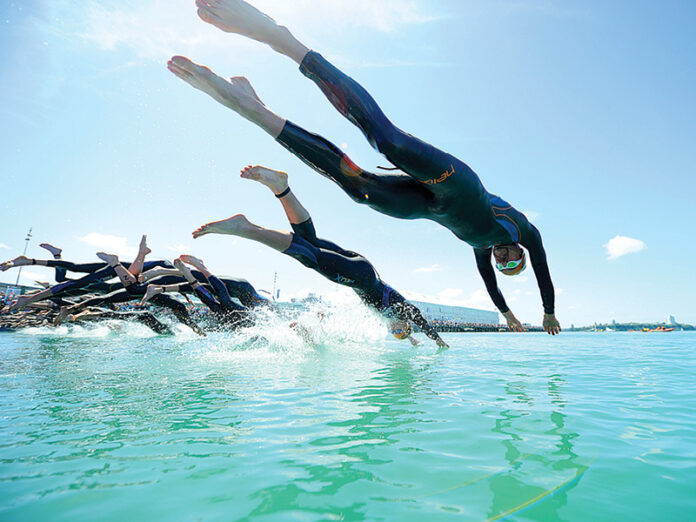
‘Tis the season to start thinking about your first race in 2015. And for some of you, it truly might be your very first triathlon.
You have likely been reading triathlon books and magazines so you have plenty of advice on how to get to the start line. But here are some tips learned from experience — not from a textbook. I implemented them for every race of my 20-year career. Some things you have to learn by making mistakes. Hopefully these ideas will minimize mistakes and maximize the joy of crossing that finishing line.

Photo: Delly Carr, ITU
- Prior to the event, test all of your gear – race uniform, race wheels, race shoes, pre-race breakfast, race-day nutrition. Then don’t change anything before the event.
- Get your bike tuned a week prior to race day and test it in your pre-race rides.
- If possible, check out the course prior to race day. The ideal would be to swim, bike and run on the actual course, but driving the bike course and riding the run course can be a huge asset. Pick landmarks on the course you can re-visit on race-day to make yourself feel at home on the course. See yourself being proficient through all of the difficult sections of the course and mentally turn those difficult sections into your areas of expertise. What you visualize is what you will actualize so see yourself making good decisions, executing perfectly and dealing with the curveballs like a master.
- Shorten workouts the week prior to your event. And while you decrease the volume of workouts, increase the speed of your sessions. For example, rather than riding 40K, ride 20K but include 2 x 5 km/h faster interval to get a feel for race effort.
- If you are planning a day off before the race, choose the day 48 hours before the race rather than the day 24 hours before. Athletes find themselves lethargic and sluggish after a day-off. It is important to get out for a 30-40 minute ride with a 20 minute run off the bike with a few accelerations. The purpose is to wake up your muscles, enhance the storage of glycogen, stimulate blood flow and simulate race effort.
- Prior to race day, walk through the race venue. How will you get to the swim start? What timing will allow you to get to the swim start with enough time to put on a wetsuit, do some positive visualization, do a swim warm up and line up for the race start? Walk through the swim to bike transition and the bike to run transition.
- A few days prior to race day, make a list of every item you need for the race. It is easier to pack your gear following a list rather than from memory.
- Learn how to change a flat tire, practice it and visualize it. Being able to calmly fix your gear is a skill, which can make an unfortunate situation bearable and empowering.
- Establish a theme for your race day. Maybe this event is your first step to fitness in your forties. Your theme might be a celebration of the next decade of your life.
- Set internal race goals that you can control. For example, my internal goals would be, “I will swim, bike and run with proper technique. I will execute good rhythm and roll and rotation during the swim. I will always find the perfect gear on the bike; I will keep my cadence high and keep constant pressure on the pedals; I will dance up the hills. I will attack the run and I love going fast. I will use my hip flexors and run tall with good turnover.”
- Ignore external goals, the ones we cannot control such as, “I will break two hours in my first Olympic distance triathlon.” These goals just lead to disappointment since you end up fixating on time rather than on process. If a day is hot or windy, then even realistic time goals become impossible. It is such a shame to allow a watch or wattage meter influence the opinion of our race. You are not a machine. Don’t let yourself be controlled by a machine.
- See yourself being in control all day. Your mental attitude is the one thing you can control on race day. You cannot control the weather, but you can control how you will react to it. You cannot control the course, but you can swim, bike and run according to your skillset and fitness level. You cannot control the competition, but you can control your execution of your race from start to finish.
- Absolutely do a swim warm up. Not only will you elevate your heart rate so that you can swim fast, but it will calm you down and help prevent hyperventilating when the race begins.
Never stop smiling. Your first triathlon is a gift. Life will never be the same! Welcome to the sport!

Photo: Delly Carr, ITU
Tri Pro Quick Tips
- Put baby powder in your wetsuit when dry to help the wetsuit slip off easily.
- Put Vaseline on the seams of your race uniform to prevent chafing.
- Put Vaseline around your neck to protect against the wetsuit.
- Put baby powder in your cycling shoes and running shoes so your feet slide in easily.
- If you don’t wear socks on the run, put Vaseline in your running shoes along the seams to prevent blisters.
- Don’t use your towel as just a placemat for your cycling and running gear. Keep part of it clear so you can actually stand on it and wipe the dirt off your feet.
















